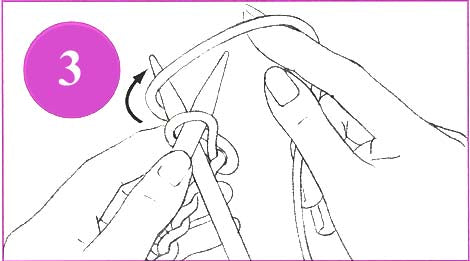Glossary: knit

Glossary: k = knit
Knitting is the art of creating a fabric by making interlocking loops of yarn. There are two basic ways to create these loops:
- The action of inserting your needles through the bottom of a loop and pulling a new loop down and through the first loop is called 'knitting'.
- The action of inserting your needles from the top of a loop and pulling a new loop up and through the first stitch is called 'purling'.
You can insert the working needle (the needle held in the right hand) into the working stitch (the one on the left needle) either in on top (in front) or underneath (in back) of the left needle. When you insert the working needle underneath, this is called 'working through the back loop'. When you insert the working needle on top, this is called 'working through the front loop'. Combining knit or purled stitches and changing whether the stitch is worked through the back or front loop gives a knitted fabric its texture and pattern.
There are different methods for holding the yarn and needles. In the 'English' method, the yarn is controlled and looped (or 'thrown') with the right hand to create stitches. In the 'Continental' method, the yarn is controlled in the left hand and the stitches are made by 'picking' loops off the left needle with the needle held in the right hand. Some knitters feel that the Continental method is faster because there is less waste motion. Because the yarn is controlled in the left hand, the Continental method may also be a little easier for left-handed knitters and somewhat more difficult for right-handed ones. Both methods work well and if one does not feel comfortable to you, you may want to try the other one. If you are left-handed and find that neither method is comfortable, you may want to look for a tutorial on mirror knitting, a technique that can be used to create knitted pieces without going through the process of reversing the pattern.
This tutorial teaches you how to knit using the English method. The tutorial is available in both video and written format.
Video Instruction: Making a knit stitch ('garter stitch')
Written Instruction: Making a knit stitch ('garter stitch')
- Start by casting on as many stitches as are required by your pattern. When your cast-on is ready, hold the needle with the cast-on stitches on it in your left hand so that the first stitch is approximately one inch [2.5 cm] from the top of the needle. Loop the yarn that goes from the bottom of the first stitch to ball over the top of the forefinger of your right hand and hold the empty needle in your right hand.

- Guess what? You already know what to do next! Insert the tip of the right needle into the stitch closest to the tip of the left needle. This is the same way that you inserted the needle in step 4 when casting on.

- Move your left hand so that both needles are held in your left hand between your thumb and your forefinger. Using your right forefinger, wrap the yarn from the stitch on the left needle up and over the top of the right needle in a clockwise motion (this is the direction that the hands on a clock move). This is the same motion that you used in step 6 in the section on casting on.

- Slide the right needle (with the loop of yarn on it) down and towards you through the center of the stitch that is on the left needle.

Pull the yarn that is around the tip of the right needle down and through the stitch on the left needle to create a new loop ('stitch') on the right needle. This is the same motion you used in step 7 when casting on.

- Now for something new! Slip the new stitch and the stitch from the left needle to which it is connected completely off the tip of the left needle.

You now have one stitch on your right needle.
CONGRATULATIONS! You have just knit your first stitch!
Now continue repeating steps 1 through 7 until you have knit all the stitches off of your left needle and onto your right one. When you reach that last stitch DON'T PANIC. Just knit the stitch. You have now completed a ROW. Note that the cast-on does not count as a row if you are knitting a piece where you have to count rows. What you have just finished-- cast-on included -- is row 1.
When the row is finished, it is time to turn your work. Exchange the empty needle in your left hand with the full needle in your right and begin again.
Just remember that knitting is a 4-step process:
- Insert the needle
- Wrap the yarn
- Pull through the loop
- Pull off the new stitch
After you have knit several rows, the fabric you are making will feel bumpy and you'll be able to tell that it is composed of a series of ridges. Each ridge is created by two rows of knitting. The ridges are on both sides of the knitted fabric and you can easily see and feel them.

This is called the GARTER STITCH.
Fabric that is made completely in garter stitch is very stable and stretchy. Pieces made in garter stitch do not curl. Because of this characteristic, garter stitch edges are often used to stabilize pieces of knitted fabric so that they will lie flat.
